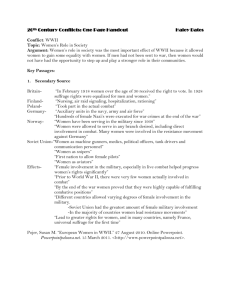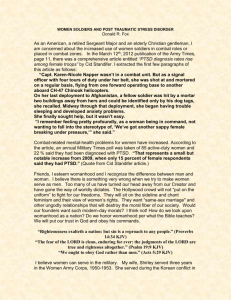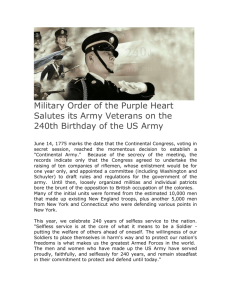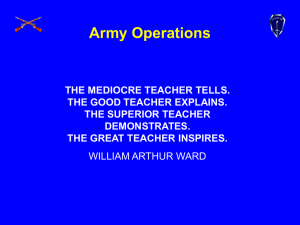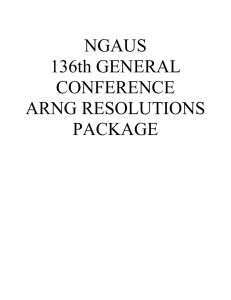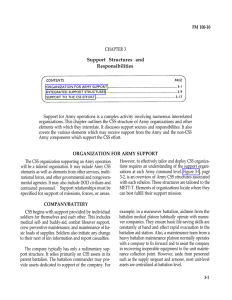sample information paper (clean)
advertisement
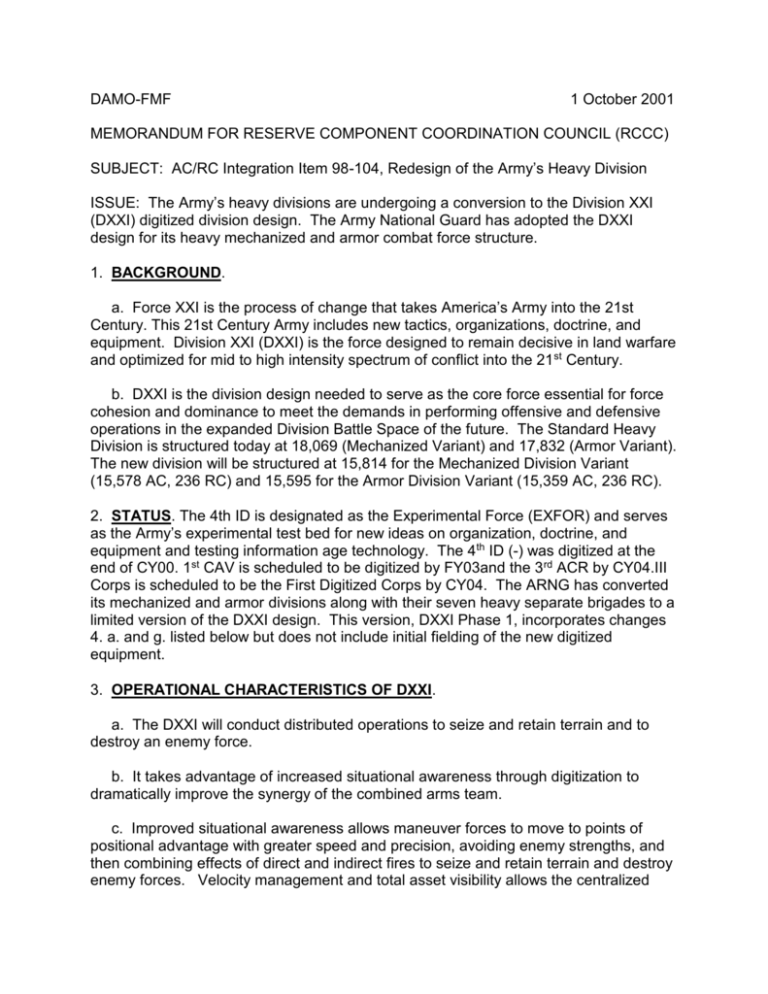
DAMO-FMF 1 October 2001 MEMORANDUM FOR RESERVE COMPONENT COORDINATION COUNCIL (RCCC) SUBJECT: AC/RC Integration Item 98-104, Redesign of the Army’s Heavy Division ISSUE: The Army’s heavy divisions are undergoing a conversion to the Division XXI (DXXI) digitized division design. The Army National Guard has adopted the DXXI design for its heavy mechanized and armor combat force structure. 1. BACKGROUND. a. Force XXI is the process of change that takes America’s Army into the 21st Century. This 21st Century Army includes new tactics, organizations, doctrine, and equipment. Division XXI (DXXI) is the force designed to remain decisive in land warfare and optimized for mid to high intensity spectrum of conflict into the 21 st Century. b. DXXI is the division design needed to serve as the core force essential for force cohesion and dominance to meet the demands in performing offensive and defensive operations in the expanded Division Battle Space of the future. The Standard Heavy Division is structured today at 18,069 (Mechanized Variant) and 17,832 (Armor Variant). The new division will be structured at 15,814 for the Mechanized Division Variant (15,578 AC, 236 RC) and 15,595 for the Armor Division Variant (15,359 AC, 236 RC). 2. STATUS. The 4th ID is designated as the Experimental Force (EXFOR) and serves as the Army’s experimental test bed for new ideas on organization, doctrine, and equipment and testing information age technology. The 4th ID (-) was digitized at the end of CY00. 1st CAV is scheduled to be digitized by FY03and the 3 rd ACR by CY04.III Corps is scheduled to be the First Digitized Corps by CY04. The ARNG has converted its mechanized and armor divisions along with their seven heavy separate brigades to a limited version of the DXXI design. This version, DXXI Phase 1, incorporates changes 4. a. and g. listed below but does not include initial fielding of the new digitized equipment. 3. OPERATIONAL CHARACTERISTICS OF DXXI. a. The DXXI will conduct distributed operations to seize and retain terrain and to destroy an enemy force. b. It takes advantage of increased situational awareness through digitization to dramatically improve the synergy of the combined arms team. c. Improved situational awareness allows maneuver forces to move to points of positional advantage with greater speed and precision, avoiding enemy strengths, and then combining effects of direct and indirect fires to seize and retain terrain and destroy enemy forces. Velocity management and total asset visibility allows the centralized DAMO-FMF SUBJECT: AC/RC Integration Item 98-104, Redesign of the Army’s Heavy Division Combat Support/Combat Service Support (CS/CSS) system to improve effectiveness with a decrease of CSS personnel. 4. SIGNIFICANT ORGANIZATION CHANGES. a. Reduces Abrams and Bradley systems from 58 to 44 per battalion. Additionally, the increase to 3 squads with 9 infantrymen each (total 27) per platoon significantly enhances the dismounted fighting capability of mechanized infantry organizations. b. Combat Service Support (CSS) functions in maneuver units move to the Division Support Command (DISCOM). This allows for a distribution based supply system, reduced stocks and provides for centralized CSS for Maneuver and Engineer units within the Division. Additionally, CSS enablers such as Movement Tracking System (MTS), Palletized Loading System – Transportation Motor Transport (PLS-TMT), Global Combat Support System – Army (GCSS-A), Combat Service Support Control System (CSSCS), and Forward Repair System (FRS) enhance the efficiencies of the redesigned Heavy Division CSS organizations. c. Adds a 49-man reconnaissance troop for each maneuver brigade. d. Dual-missions an ARNG MLRS battery as the third battery of the 3x6 divisional MLRS battalion. e. Eliminates Engineer Brigade Headquarters and retains 3 Engineer Battalions with 3 companies each. Increases engineer staff in the division headquarters from three to twenty-eight personnel. f. Adds a third General Support Aviation Company (GSAC/ARNG) to the General Support Aviation Battalion. g. Standardizes mortars to four tubes per battalion. h. Creates a Rear Operations Center (ROC) that is organic to the DXXI division troops. The ARNG will resource this unit in AC DXXI divisions. 5. MILESTONES. Joint Venture is the main effort and will redesign the Army’s operating forces. The 4th ID(-) conducted a Division Capstone Exercise (DCX) in FY01 to demonstrate the new capability instituted through modernization and digitization. A follow event (DCX II) will occur October 2001. 6. RESOURCE IMPLICATIONS. a. Reserve Component Manning. Three hundred forty six (346) of four hundred eight (408) RC soldiers (85%) required in the 1 BCT (e-date 990616), 2 BCT (e-date 990916) and Division (-) (e-date 991016) have been assigned. USAR/USAREC identified MOS 91B (Medical Specialist) and MOS 77F (Petroleum Supply Specialist) as 2 DAMO-FMF SUBJECT: AC/RC Integration Item 98-104, Redesign of the Army’s Heavy Division particularly difficult MOSs to recruit in the Ft. Hood geographical area. FORSCOM requested conversion of 40 of these previously identified RC spaces to AC. HQDA approved this request and will restore 38 spaces in FY01 and 2 in FY 04. FORSCOM also requested restoration of 333 AC spaces in 1CD previously identified as RC. After careful consideration in TAA-7.1, HQDA approved restoration of 279 of these 333 spaces in FYs 01-03. Dual-missioning of ARNG GSAC and MLRS Battery and singlemissioning of the ROC remain as scheduled. ODCSOPS, NGB, OCAR, and FORSCOM are currently reviewing the DXXI RC resourcing model for 3ID, tentatively programmed to convert to the DXXI design in FY05-FY07. 7. CONGRESSIONAL INTEREST. Limited 8. COORDINATION. NGB-ARF, OCAR, DAMO-ADO, PA&E, ASA(M&RA) 9. RECOMMENDATION AS AN RCCC AGENDA ITEM. Review this issue on a quarterly basis. ____________________________ COL Wilson, Deputy Director, AC/RC Integration _____________________ LTC Reynolds/693-8051 3

